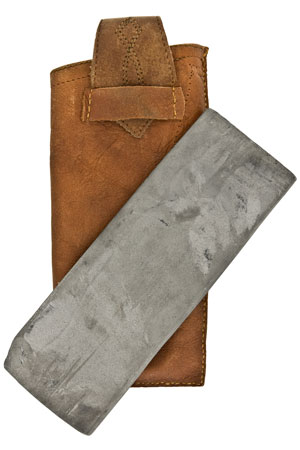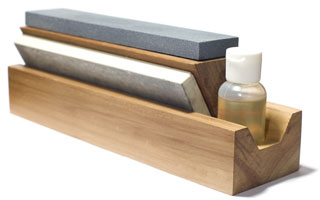Wood Carving Tool Sharpening
Wood Carving Tools • Tool Care • Tool Safety • Tool Sharpening
Hand Carving Tools • Wood Carving Toolmakers • Wood Carving at eBay
 Every woodcarver must sharpen his tools. It is a skill that is necessary to learn so that the wood is not torn by a
blunt edge. The cutting edges of your chisels and gouges must be carefully honed to keep them very sharp. The
tools may be sharp to start with, but they need to be re-sharpened or stropped as the work proceeds so that they will
continue to cut well. Sharpening and caring for wood carving tools is an important task for wood carvers.
Every woodcarver must sharpen his tools. It is a skill that is necessary to learn so that the wood is not torn by a
blunt edge. The cutting edges of your chisels and gouges must be carefully honed to keep them very sharp. The
tools may be sharp to start with, but they need to be re-sharpened or stropped as the work proceeds so that they will
continue to cut well. Sharpening and caring for wood carving tools is an important task for wood carvers.
When wood carving tools are sharp, less effort is needed to cut the wood. This in turn speeds up the carver's work and makes it more efficient. Correctly sharpened tools make it easier to cut both with and across the wood's grain. A really sharp tool leaves a polished surface cut. These cuts, straight from the chisel and gouge, have crisp lines and edges. The resulting finish will show these lines rather than having to sand out rough edges made with blunt tools. If sanding is needed, complete the carving before sanding the surface. The sanded surface will blunt wood carving tools.
An abrasive stone is used for sharpening wood carving tools. Sharpening stones can be purchased as either waterstones or oilstones in a range of grades from coarse to fine. Combination stones are also available with fine grit on one side and medium or coarse grit on the other side. Oilstones are harder than waterstones and will last longer. You may also be able to purchase natural oilstones such as Arkansas stones that give a finer edge. Slipstones, which are made of oilstone material, are rounded and shaped to sharpen the inner bevel on gouges. They are purchased sized to fit the curve of each gouge. You may have to use a water-cooled grinding stone to repair any damaged edge before sharpening.
 To sharpen your wood carving tools, spread a small amount of light machine oil on an oilstone. If your tool edge is
dull, start sharpening with the coarse face of the stone; otherwise simply use the fine face of the stone. Wood
carving chisels have a bevel on both sides of the blade; therefore, both sides of the tool need to be sharpened. A
chisel should be sharpened at a constant angle with steady pressure, while pushing it back and forth on the length of the
stone. Hone the edge further on a finer stone; then use a leather strop to polish and remove any residue that
remains from sharpening on the stone. Gouges are similarly sharpened; however, use a rocking movement when moving it
across the stone to sharpen the outer bevel. Keep the angle low and the pressure even. Do not round off the
corners. Use an appropriately shaped slipstone to hone the inner bevel. Strop the outer bevel edge to give it
a final razor edge, and use a folded or shaped piece of leather for the inner bevel. Occasionally using a strop
during the carving process will keep the edge sharp.
To sharpen your wood carving tools, spread a small amount of light machine oil on an oilstone. If your tool edge is
dull, start sharpening with the coarse face of the stone; otherwise simply use the fine face of the stone. Wood
carving chisels have a bevel on both sides of the blade; therefore, both sides of the tool need to be sharpened. A
chisel should be sharpened at a constant angle with steady pressure, while pushing it back and forth on the length of the
stone. Hone the edge further on a finer stone; then use a leather strop to polish and remove any residue that
remains from sharpening on the stone. Gouges are similarly sharpened; however, use a rocking movement when moving it
across the stone to sharpen the outer bevel. Keep the angle low and the pressure even. Do not round off the
corners. Use an appropriately shaped slipstone to hone the inner bevel. Strop the outer bevel edge to give it
a final razor edge, and use a folded or shaped piece of leather for the inner bevel. Occasionally using a strop
during the carving process will keep the edge sharp.
V-tools are sharpened like two chisels. Use a slipstone to clean the inside edge.